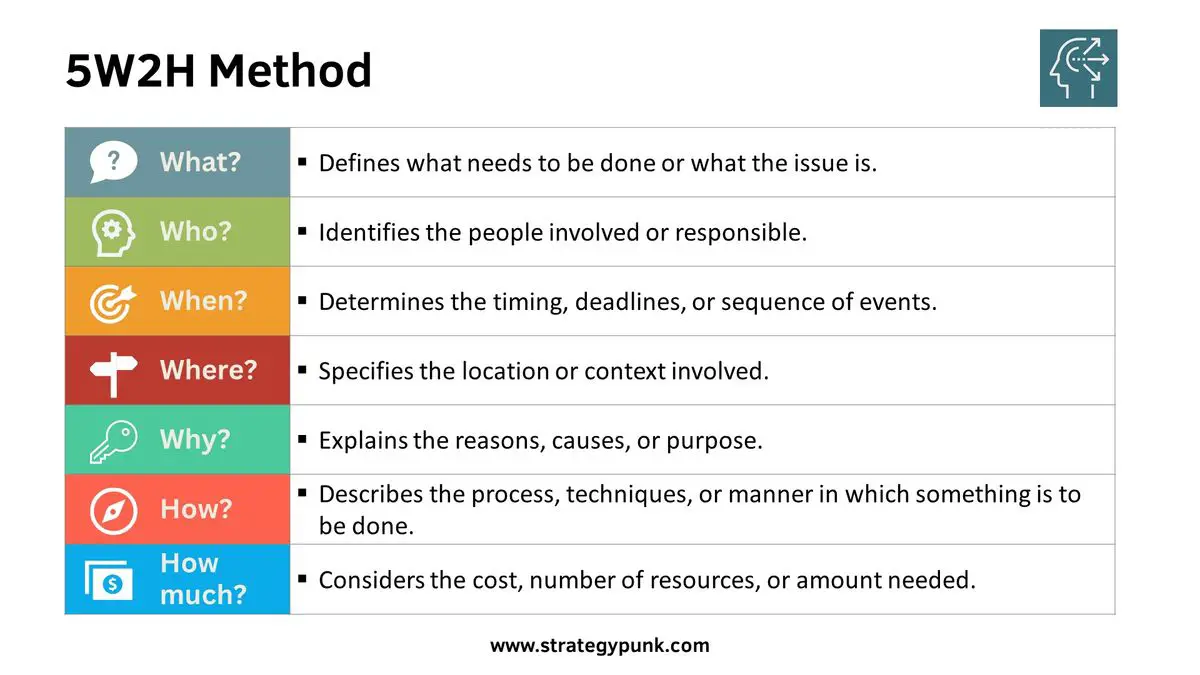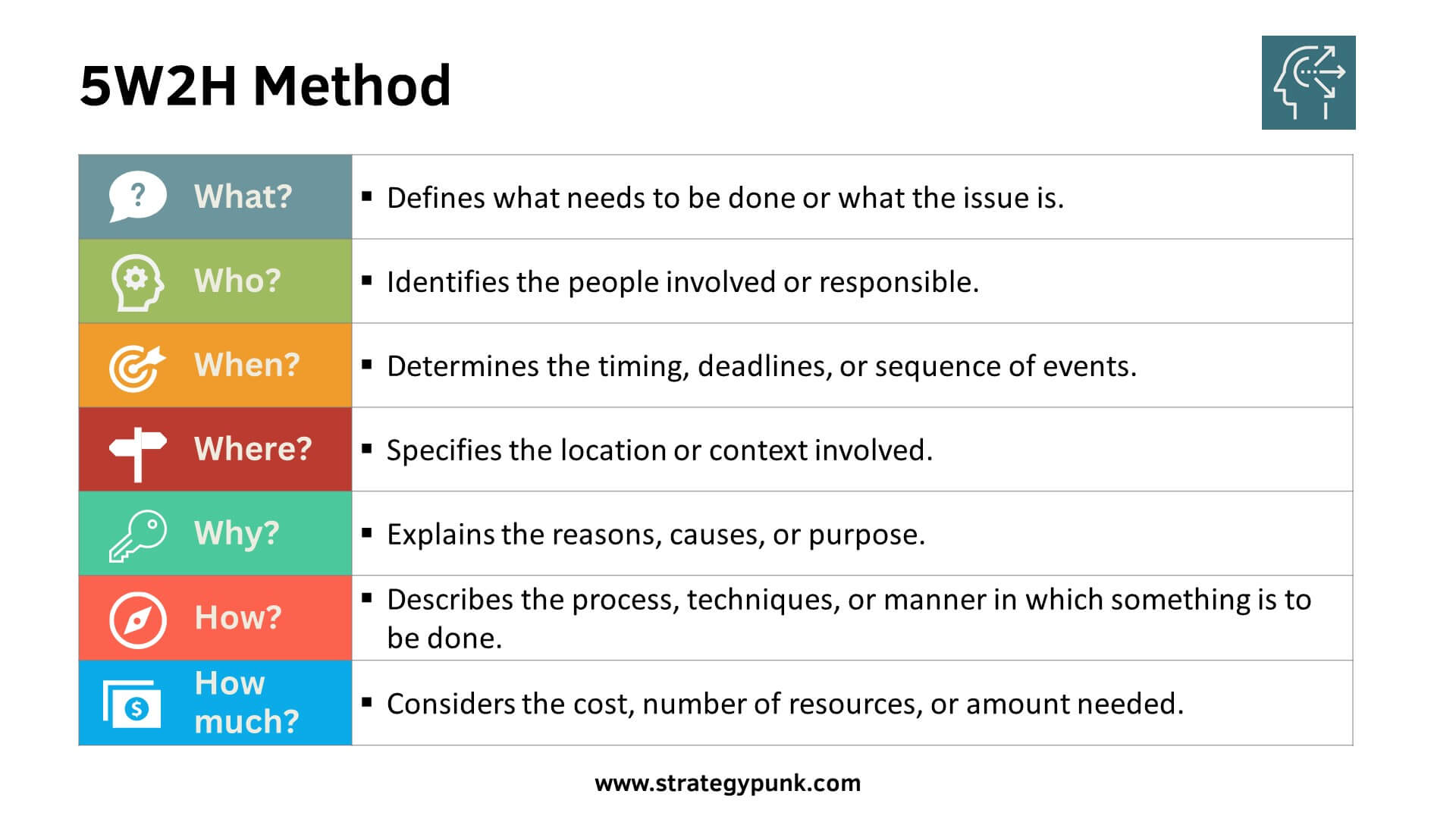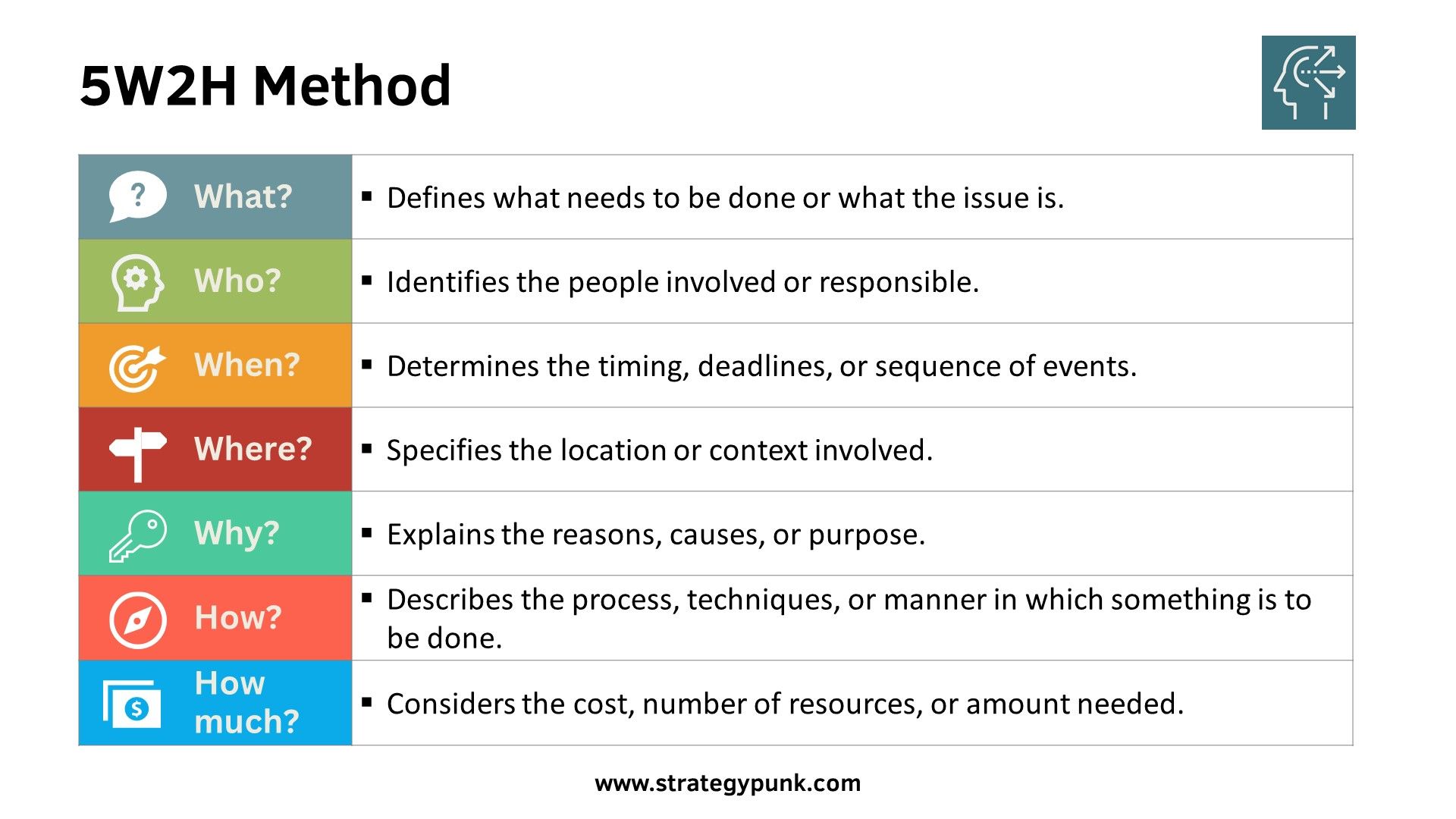The 5W2H Method: A Simple Framework for Asking the Right Questions (Free PPT)
Unlock the power of the 5W2H method—a strategic toolset for problem-solving and project analysis. Download our free, concise templates to apply this effective framework to your projects effortlessly.

Introduction
The 5W2H method is a simple yet powerful framework for asking the right questions to fully understand a situation or the root causes of a problem.
5W2H stands for the questions: what, why, where, when, Who, how, and how much.
By answering these questions, you can comprehensively understand any project, issue, or process.
To practically apply the 5W2H framework to your projects, download our free PDF and PowerPoint templates, which are available at the end of this blog post.
What is the 5W2H Method?
The 5W2H method originated in the 1960s as a quality management tool. It was initially developed in Japan, where it is sometimes referred to as the "Seven Qs."
The technique spread to the West and became popularized as the "Five Ws and Two Hs."
The method involves asking structured questions to analyze an existing or proposed process. The questions aim to gather all the pertinent details needed to comprehend the situation 5W2H can be used to fully:
- Define the scope of a project
- Investigate problems
- Develop action plans
- Create reports
- Optimize processes
One of the 5W2H technique's most significant advantages is its simplicity. It can be easily understood and applied by anyone in an organization.
The 7 Questions of the 5W2H Matrix
Let's take a closer look at each of the seven questions:
What
The "what" questions aim to describe the specifics of the subject or issue. Do you know what is being looked at? What are we trying to accomplish? Defining the objectives upfront provides focus and clarity.
Why
The "why" questions examine a project or process's reasons, purpose, and justification. Why does this need to be done? Why is this important to the organization? The answers often provide rationale and context.
Where
"Where" refers to the activity's location or scope. Where will this take place? Answering this question defines the boundaries and settings.
When
The "when" questions ask about timeframe and scheduling. When will this begin? When will each step happen? When will this be completed? The answers help with planning and coordination.
Who
"Who" identifies the people, roles, and responsibilities involved. Who will work on each piece? Who will oversee the project? Who will approve? Defining the "who" ensures accountability.
How
The "how" questions focus on process, execution, and methodology. Would you happen to know how this will be done? How will each step happen? The answers provide actionable specifics.
How Much
Lastly, "how much" refers to the budget, resources, and costs required. How much time will it take? How much money will be needed? Quantifying the inputs leads to more accurate planning.
How to Apply the 5W2H Method
There are five key steps to putting the 5W2H technique into practice:
- Define the Objective - Identify the project, problem, or process being examined.
- Develop the Questions—Brainstorm the detailed 5W2H questions that must be answered to understand the objective fully.
- Gather the Information - Research, interview, inspect, and analyze to get the data needed to answer each question.
- Answer the Questions - Document comprehensive responses for each of the 5W2H questions.
- Summarize the Findings - Compile the information into a report detailing the current state and recommendations.
The 5W2H method can be applied flexibly. The depth of the questions and data gathered will depend on the objective's scope and complexity. A high-level 5W2H analysis may be sufficient for relatively minor issues or projects. For major initiatives, an in-depth investigation into each question is likely needed.
Benefits of the 5W2H Technique
Applying the structured 5W2H questioning approach offers many benefits:
- Simplicity - The technique is easy to understand and does not require statistical skills.
- Thoroughness - Answering the 7 Qs provides comprehensive information.
- Clarity - 5W2H forces specificity and details that avoid ambiguity.
- Alignment - Stakeholders get on the same page by sharing a common understanding.
- Organization - Information is logically categorized for better analysis and planning.
- Accountability - Assigning the "who" and "when" creates ownership.
- Value - The small time investment in 5W2H saves time and resources.
- Adaptability - The method can be applied at tactical and strategic levels.
Use Cases for the 5W2H Technique.
The simple but systematic structure of 5W2H makes it a versatile tool for a wide range of business applications:
- Process Optimization - Map out an existing process using 5W2H to highlight areas for improvement.
- Project Planning - Define the details of an upcoming project using the 7 Qs.
- Systematic approach to problem-solving - Investigate the root causes of an issue using 5W2H analysis.
- New Product Development - Detail a new product concept using the 5W2H framework.
- Quality Control - Apply 5W2H to understand defects and implement preventive controls.
- Event Planning - Use 5W2H to orchestrate the specifics of an upcoming event.
- Business Proposals - Structure proposals and action plans using the 5W2H questions.
- Meeting Preparation - Define the purpose and required outcomes of a meeting in 5W2H terms.
What is the difference between 5W2H and 5W1H methods?
The bottom line is that 5W2H can be leveraged to define and comprehensively understand virtually any business activity or scenario. Taking the time upfront to answer the 7 Qs thoroughly helps prevent wasted efforts, delays, and costs.
Here are the key differences between the 5W1H and 5W2H methods:
Number of Questions:
- 5W1H consists of 5 questions - What, Who, When, Where, Why
- 5W2H consists of 7 questions - What, Who, When, Where, Why, How, How Much
Scope:
- 5W1H focuses on gathering high-level information about a problem or situation
- 5W2H goes more in-depth by also asking "How" something occurred and "How much" it impacted things
Origins:
- 5W1H originated in journalism and research
- 5W2H originated as a quality management tool in manufacturing in Japan
Purpose:
- 5W1H aims to gather the basic facts and details
- 5W2H is more problem-solving focused - gathering details to understand causes and impacts
Use Cases:
- 5W1H is commonly used in research reports, documentation, and presentations
- 5W2H is more commonly used for root cause analysis, continuous process improvement, and corrective actions
5W1H provides a high-level overview, while 5W2H enables a deeper dive into problems or processes.
5W1H gives the basic information, while 5W2H also uncovers the causes, impacts, and solutions.
5W2H method examples
Example 1: Implementing a Remote Work Policy for a Tech Company
Context:
Many companies are refining their remote work policies in response to the evolving work environment post-pandemic. This example outlines a project to update and implement a comprehensive remote work strategy.
- Who:
- HR department, IT team, department heads, and remote employees.
- External consultants specializing in remote work strategies.
- What:
- Develop and implement a modern remote work policy.
- Equip employees with necessary tools and cybersecurity training.
- Revise communication protocols and performance evaluation methods.
- When:
- Project kickoff: Q1 2023.
- Pilot phase: Q2 2023.
- Full implementation: Q3–Q4 2023.
- Regular reviews: Bi-annually starting in 2024.
- Where:
- The initiative will be executed company-wide, focusing on regions that have transitioned primarily to remote work.
- Online platforms for policy rollout and training sessions.
- Why:
- To improve employee work-life balance, attract talent globally, and enhance productivity.
- Adapt to post-pandemic trends and future-proof the workforce.
- Reduce operational costs associated with physical office spaces.
- How:
- Conduct surveys and focus groups to gather feedback on current challenges.
- Collaborate with IT to deploy secure collaboration and communication tools.
- Organize training sessions for employees and managers on best remote work practices.
- Establish clear guidelines and performance metrics.
- How Much:
- Budget allocation: Approximately $100,000 for tool upgrades, training programs, and consultancy fees.
- Time investment: 6–9 months for a full rollout, with ongoing support and periodic evaluations.
Example 2: Launching an AI-Driven Customer Service Chatbot for an E-commerce Platform
Context:
In 2023 and 2024, many businesses will use AI to enhance customer service. This project uses an AI chatbot to improve response times and customer satisfaction.
- Who:
- Customer Service and IT departments.
- External AI solution providers and developers.
- Marketing team for promotion and customer onboarding.
- What:
- Develop, test, and deploy an AI-powered chatbot integrated into the company’s website and mobile app.
- Include capabilities for handling common queries, order tracking, and basic troubleshooting.
- Set up a seamless escalation process for human agents when needed.
- When:
- Initial research and vendor selection: Q3 2023.
- Development and testing: Q4 2023 to Q1 2024.
- Full deployment: Q2 2024.
- Ongoing improvements: Continuous after launch.
- Where:
- The chatbot will be integrated across all customer-facing digital channels.
- Development work will be managed both in-house and by remote vendor teams.
- Why:
- To reduce customer wait times and improve overall satisfaction.
- To free up human agents for more complex inquiries.
- Collect data and insights on common customer issues for further business improvements.
- How:
- Select an AI vendor with a strong NLP (Natural Language Processing) and customer service track record.
- Run pilot programs on the website and app to gather initial feedback.
- Use agile methodologies for iterative development and improvements.
- Train customer service teams on how to work alongside the AI tool.
- How Much:
- Estimated cost: $150,000 for development, integration, and initial maintenance.
- Expected ROI: Reduction in customer service costs by 20–30% within the first year of full deployment.
Example 3: Developing a Sustainable Packaging Initiative for a Consumer Goods Company
Context:
Environmental sustainability has become a key focus for businesses worldwide. This project aims to transition a product line to eco-friendly packaging solutions in response to consumer demand and regulatory pressures over the last two years.
- Who:
- Sustainability team, Product Development, and Supply Chain Management.
- External environmental consultants and packaging suppliers specializing in sustainable materials.
- The marketing team will communicate changes to consumers.
- What:
- Research and source sustainable packaging materials.
- Redesign product packaging to reduce plastic use and incorporate recycled materials.
- Develop a marketing campaign to educate consumers about the environmental benefits.
- When:
- Research and supplier engagement: Q1 2023.
- Design and prototype development: Q2–Q3 2023.
- Pilot testing and feedback collection: Q4 2023.
- Full rollout: Q1 2024.
- Evaluation and adjustments: Ongoing reviews every 6 months.
- Where:
- Implementation across all product lines in key markets.
- Coordination with global suppliers and manufacturers.
- Why:
- To meet increasing consumer demand for sustainable products.
- To comply with emerging environmental regulations.
- To enhance brand reputation and reduce the company’s environmental footprint.
- How:
- Conduct a lifecycle analysis of current packaging and identify improvement areas.
- Partner with suppliers who provide certified sustainable materials.
- Redesign packaging with input from focus groups and sustainability experts.
- Launch a marketing campaign emphasizing the company’s commitment to sustainability.
- How Much:
- Investment: Estimated $200,000 covering research, design, supplier negotiations, and marketing.
- Anticipated cost savings: Reduced waste management fees and potential tax incentives.
- Long-term financial benefits from enhanced brand loyalty and market differentiation.
Frequently Asked Questions
What is the difference between 5W2H and 5 Whys?
The 5 Whys is a questioning approach focused on determining the root cause. 5W2H has a broader scope, looking at project management or process details.
When should 5W2H be used versus other problem-solving tools?
5W2H is accessible and an excellent initial tool for clarifying objectives and gathering information. As needed, more complex analysis tools can then be applied.
Is there a standard template or format for documenting 5W2H?
There is no single mandated format. The analysis can be captured in a table, bulleted lists, paragraph form reports, or visual workflow diagrams.
Can 5W2H be used individually, or is it better used in a group setting?
It can be used individually, but 5W2H to align a team or group often provides broader insights.
Is the order of the 5W2H questions important?
There is no required sequence, but starting with "what" and "why" can provide helpful context for the ensuing questions.
5W2H vs. PDCA (Plan-Do-Check-Act): Comparison and How They Complement Each Other
Focus and Scope:
- 5W2H is detail-oriented, answering specific questions to understand or thoroughly plan a project or issue.
- PDCA provides a broader framework for ongoing improvement, emphasizing iterative cycles of planning, executing, reviewing, and acting.
Application Stage:
- 5W2H is often used during the "Plan" stage (within PDCA or independently) to consider all aspects of the issue thoroughly.
- PDCA guides the entire process from planning to implementation and continuous refinement.
- Iterative vs. One-Time Analysis:5W2H tends to analyze the situation and develop a detailed action plan that is comprehensively used as a one-time analysis tool to break down and understand the problem or plan.PDCA is iterative, encouraging repeated cycles of improvement.
Complementary Use:
In practice, these methods can be combined. For example, during the Plan phase of PDCA, a team might use 5W2H to analyze the situation and develop a detailed action plan comprehensively. Once the plan is implemented (Do), the PDCA cycle continues with Check and Act to ensure effective and sustained improvements.

5W2H Method PowerPoint Template
free and fully editable PPT template






